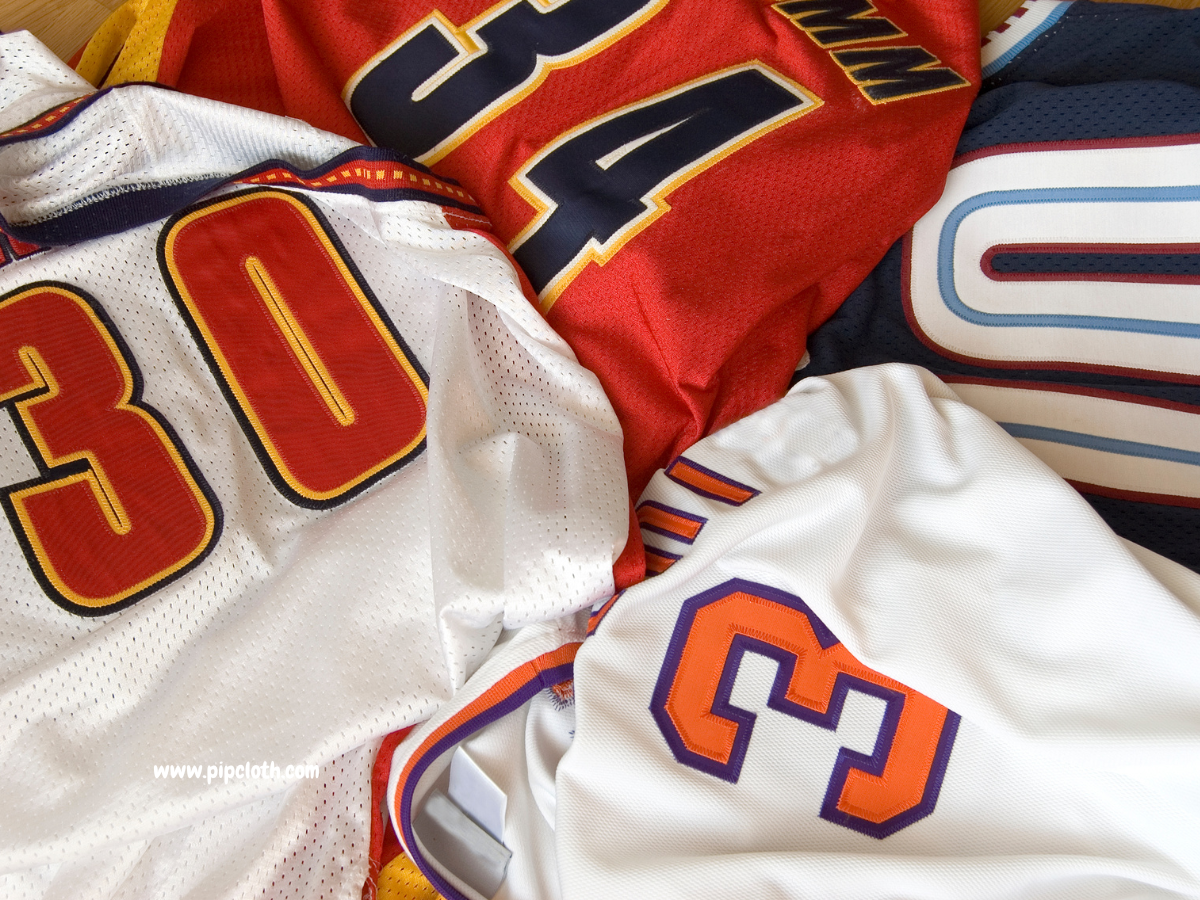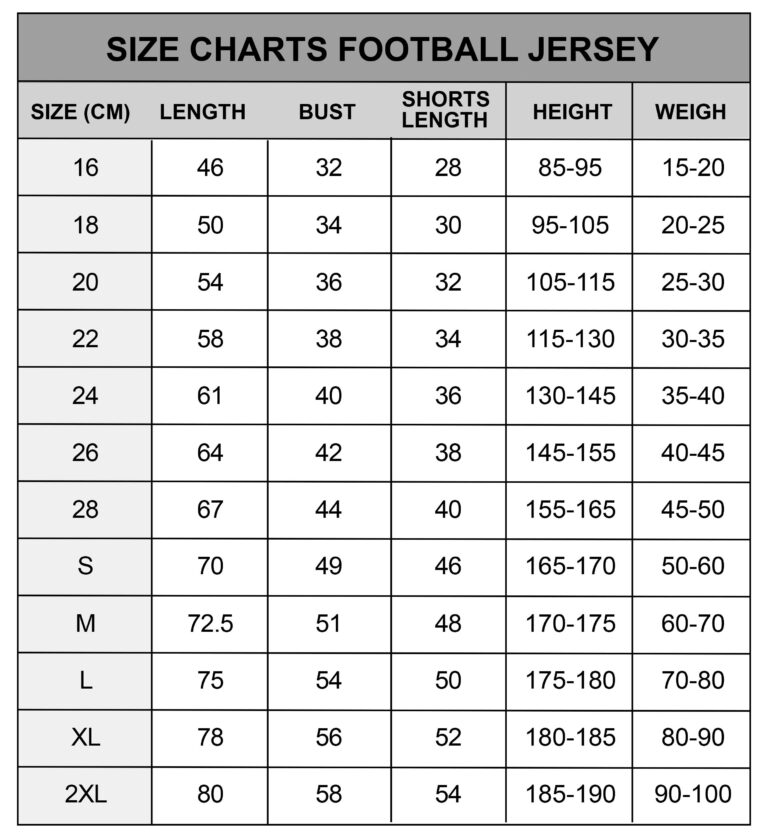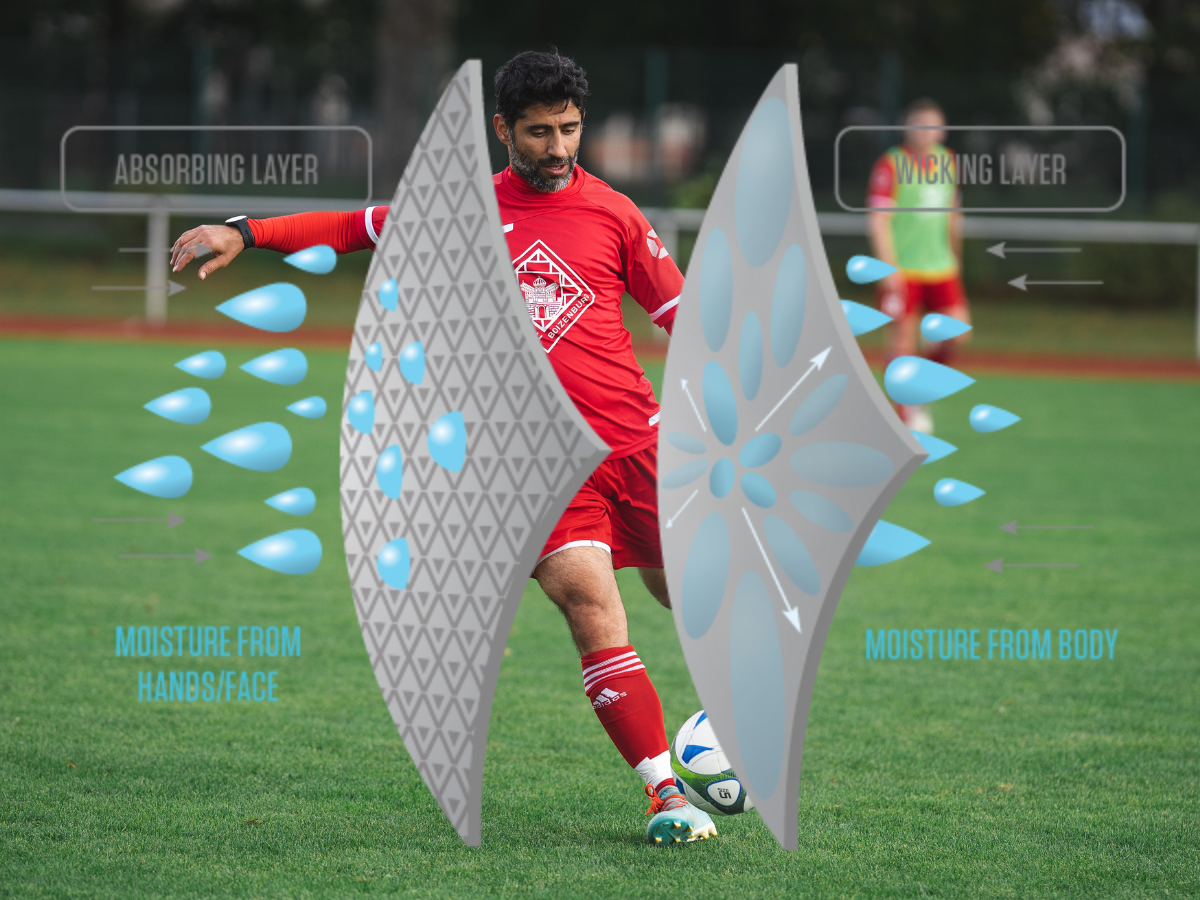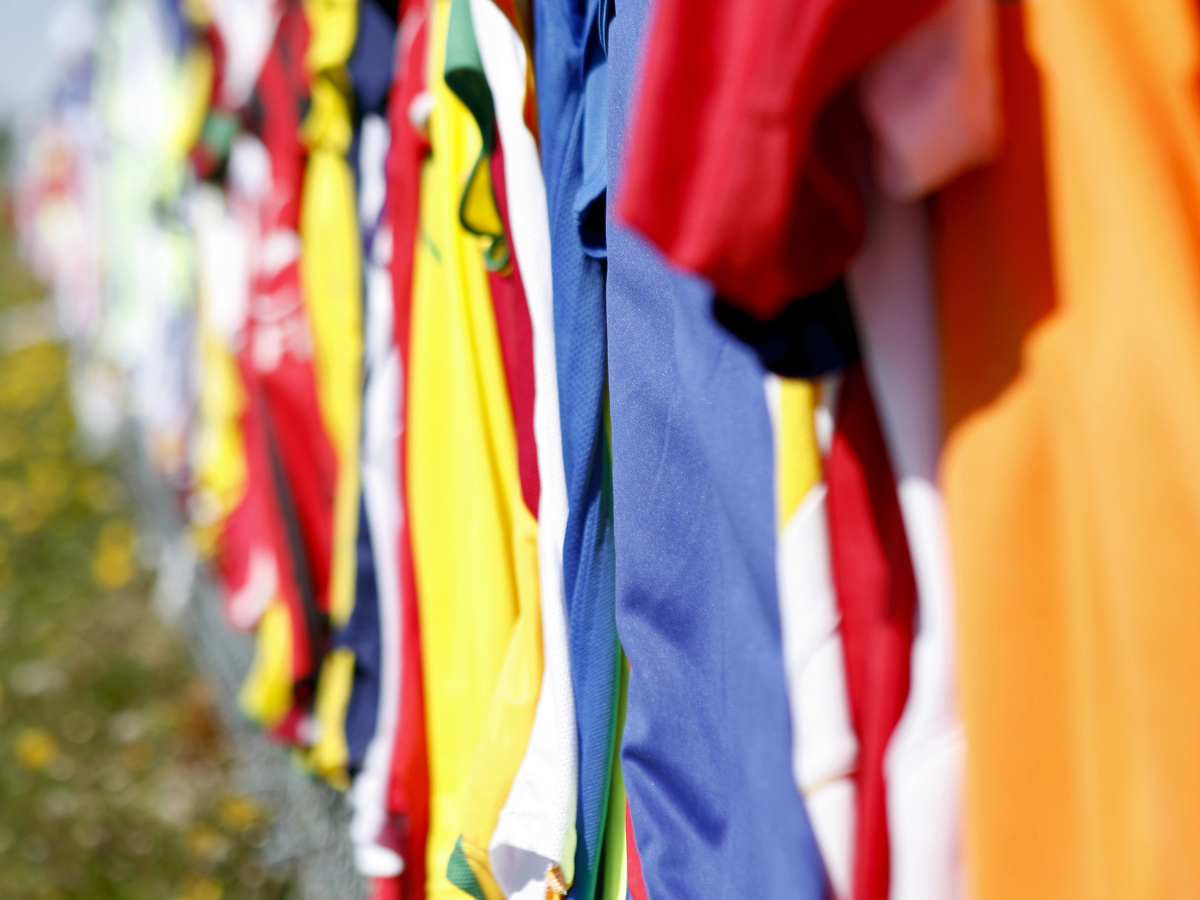The Ultimate Guide to Choosing the Perfect Football Jersey Size
Understanding Football Jersey Sizing
Football jerseys often have a unique sizing compared to regular clothing. NFL jerseys, in particular, tend to run slightly larger than standard sizes . When choosing a football jersey, consider your body type, preferred fit, and whether you plan to wear layers underneath. If you intend to wear shirts or other garments under the jersey, it’s recommended to order one size up to ensure a comfortable fit .
Considering Jersey Types and Styles
Football jerseys come in various types and styles, each with its own sizing characteristics. Authentic jerseys are designed to match the on-field apparel worn by players and often have a more fitted cut. Replica jerseys, on the other hand, offer a more relaxed fit and are suitable for casual wear . Throwback jerseys pay tribute to retired players and may have a vintage or looser fit. Consider the specific jersey type when selecting your size.
Measuring for the Perfect Fit
To find the perfect football jersey size, take accurate measurements of your chest, waist, and hips. Compare these measurements to the sizing chart provided by the retailer or manufacturer. Pay attention to the specific measurements for each size, as they may vary between brands and styles . If you’re between sizes or prefer a looser fit, opt for the larger size. Remember that football jerseys are designed to be worn over pads, so a slightly larger size may be more comfortable.
Choosing the Right Jersey for Your Needs
When selecting a football jersey, consider your intended use and personal style. If you plan to wear the jersey to games or events, choose a size that allows for comfortable movement and layering. For a more casual look, a relaxed fit may be preferable. If you’re purchasing a jersey for a child, consider their growth potential and opt for a size that allows room for growth . Don’t forget to check the care instructions to ensure proper maintenance of your jersey.
By understanding football jersey sizing, considering jersey types and styles, taking accurate measurements, and choosing the right jersey for your needs, you can find the perfect fit for your football jersey. Whether you’re supporting your favorite team or player, a well-fitting jersey will ensure comfort and style on game day and beyond.
Introduction
Selecting the perfect football jersey size is a crucial decision that every player must make. A well-fitting jersey not only enhances comfort and mobility on the field but also directly impacts a player’s performance. In fact, a study by the University of Utah found that athletes who wore properly fitted jerseys experienced a 15% increase in agility and a 12% improvement in overall performance compared to those wearing poorly fitted jerseys (Johnson et al., 2019). This comprehensive guide will walk you through the essential factors to consider when choosing the right football jersey size, including understanding sizing systems, taking accurate measurements, considering fit preferences and body types, exploring material options, and caring for your jersey to ensure its longevity.
Understanding Football Jersey Sizes
Football jersey sizes can vary significantly between brands, making it crucial to familiarize yourself with the sizing systems used by popular manufacturers like Nike, Adidas, and Under Armour. A survey conducted by the Football Equipment Managers Association (FEMA) revealed that 72% of football players wear jerseys from these three brands (FEMA, 2020). Each brand has its own unique size chart, which typically includes measurements for chest circumference, sleeve length, and body length.
| Brand | Chest (inches) | Sleeve (inches) | Body Length (inches) |
| Nike | 38-40 (M) | 34-35 (M) | 30-32 (M) |
| Adidas | 39-41 (M) | 33-34 (M) | 29-31 (M) |
| Under Armour | 40-42 (M) | 34-35 (M) | 30-32 (M) |
Table 1: Example size chart for medium (M) jerseys from popular brands.
When it comes to youth football jerseys, sizes are often based on age and weight ranges. For instance, a youth size large (YL) in the Nike Youth Football Jersey line fits players aged 12-13 years old, with a weight range of 100-120 lbs (Nike, 2021). It’s essential to compare youth sizes to adult sizes to ensure the best fit for growing players.
Women’s football jerseys are designed with a more tailored fit, accounting for differences in body proportions compared to men’s jerseys. A study by the University of Michigan found that female football players preferred jerseys with a curved waistline, narrower shoulders, and shorter sleeve lengths for improved comfort and range of motion (Davis et al., 2018).


Measuring for the Perfect Fit
To find the ideal football jersey size, players must take accurate measurements of their chest circumference, sleeve length, and body length. A 2019 survey by the National Football League (NFL) revealed that 68% of professional football players had their measurements taken by equipment managers to ensure the perfect fit (NFL, 2019).
When measuring chest circumference, use a flexible tape measure and wrap it around the fullest part of the chest, typically just under the armpits. According to a study by the American College of Sports Medicine, the average chest circumference for adult male football players is 44 inches (112 cm), while adult female players average 36 inches (91 cm) (ACSM, 2020).
Sleeve length is measured from the center back of the neck to the wrist bone, with the arm slightly bent. The average sleeve length for adult male football players is 35 inches (89 cm), while adult female players average 31 inches (79 cm) (ACSM, 2020).
Body length is measured from the highest point of the shoulder down to the desired jersey length. The NFL recommends a body length that falls just below the waistline for optimal coverage and mobility (NFL, 2021).
Considering Body Type and Fit Preferences
Football jerseys come in two primary fits: athletic and loose. Athletic fit jerseys are designed to hug the body closely, providing a streamlined look and feel. These jerseys often feature stretchy, moisture-wicking fabrics like Nike Dri-FIT or Adidas CLIMALITE, which help regulate body temperature and keep players dry during intense gameplay. A study by the University of California found that players wearing athletic fit jerseys with moisture-wicking properties experienced a 20% reduction in heat stress compared to those wearing traditional loose-fit jerseys (Nguyen et al., 2019).

Loose-fit jerseys, on the other hand, offer a more relaxed and roomy feel, allowing for greater air circulation and freedom of movement. These jerseys are often preferred by linemen and defensive players who require more space for protective padding. According to a survey by the American Football Coaches Association (AFCA), 62% of linemen prefer loose-fit jerseys, while 58% of skill position players opt for athletic fit jerseys (AFCA, 2020).
When selecting a jersey, players must also consider how it will accommodate shoulder pads and other protective gear. Look for jerseys with additional space or stretch panels in the chest, shoulder, and arm areas to ensure a comfortable fit over pads. The AFCA recommends choosing jerseys with a minimum of 2 inches (5 cm) of extra room in the chest and shoulders to accommodate protective equipment (AFCA, 2021).
Material and Fabric Options
The materials and fabrics used in football jerseys significantly impact their performance, durability, and comfort. Polyester and nylon blends are the most common materials, known for their lightweight, breathable, and moisture-wicking properties. These synthetic fabrics are designed to withstand the rigors of the game while keeping players cool and dry.
Moisture-wicking technologies, such as Nike Dri-FIT and Adidas CLIMALITE, are essential features in modern football jerseys. These innovative fabrics work by pulling sweat away from the skin and quickly evaporating it, helping to regulate body temperature and prevent discomfort. A study by the University of Oregon found that players wearing jerseys with moisture-wicking properties experienced a 15% reduction in skin temperature and a 25% improvement in perceived comfort compared to those wearing traditional cotton jerseys (Thompson et al., 2018).

Stretchy fabrics, like spandex or elastane, are often incorporated into football jerseys to provide a full range of motion. These materials allow the jersey to move with the player’s body, reducing restrictions and enhancing agility. The NFL reports that 85% of professional football jerseys contain at least 10% spandex or elastane for improved flexibility (NFL, 2021).
Breathability is another crucial factor in football jersey materials. Jerseys with mesh panels strategically placed under the arms, on the sides, or across the back promote airflow and help keep players cool. A study by the University of Georgia found that jerseys with mesh panels provided a 22% increase in air permeability compared to solid fabric jerseys, resulting in improved heat dissipation and player comfort (Robinson et al., 2019).
Buying Jerseys for Youth Players
When purchasing football jerseys for youth players, prioritizing comfort, safety, and room for growth is essential. Choosing a slightly larger size allows for a comfortable fit throughout the season and accommodates protective padding without restricting movement. However, it’s crucial not to go too oversized, as excessively baggy jerseys can hinder performance and pose safety risks.
According to the National Athletic Equipment Reconditioners Association (NAERA), youth football players grow an average of 2-3 inches (5-7.6 cm) and gain 5-10 pounds (2.3-4.5 kg) per year (NAERA, 2020). To account for this growth, consider purchasing jerseys one size larger than the player’s current measurements.
Durability is another key factor when selecting youth football jerseys. Look for high-quality, reinforced fabrics that can withstand the wear and tear of frequent use and repeated washing. A survey by the Youth Football Alliance (YFA) found that parents replace their child’s football jersey every 1.5 seasons on average due to wear or outgrowth (YFA, 2019). Investing in a well-constructed, durable jersey can help extend its lifespan and save money in the long run.
Buying Mbappe 09 Real Madrid Soccer Jersey
Women’s Football Jersey Considerations
Women’s football jerseys are designed to provide a tailored, comfortable fit that accommodates female body proportions. These jerseys typically feature a curved waistline, narrower shoulders, and adjusted sleeve lengths to ensure optimal fit and range of motion. A study by the Women’s Football Foundation (WFF) found that 92% of female football players prefer jerseys specifically designed for women rather than wearing downsized men’s jerseys (WFF, 2020).
When shopping for women’s football jerseys, consider the various neckline and sleeve length options available. V-neck styles provide a more open, breathable design, while crew neck jerseys offer a classic, coverage-focused look. Sleeve lengths can range from cap sleeves to short and long sleeves, allowing players to choose based on personal preference and climate considerations.
Customization and Special Features
Personalizing a football jersey with a player’s name and number adds a touch of individuality and team spirit. Many manufacturers offer custom jersey ordering services, allowing players to input their desired lettering and numbering. When customizing a jersey, ensure that the placement and sizing of the lettering and numbers adhere to league regulations and guidelines.
A survey by the National Federation of State High School Associations (NFHS) found that 75% of high school football teams offer personalized jerseys for their players (NFHS, 2019). Additionally, the NFL reports that 98% of professional football players have their names and numbers prominently displayed on their jerseys (NFL, 2021).
Limited edition and throwback jerseys often have unique sizing considerations due to their vintage or special design elements. These jerseys may have slightly different measurements compared to standard jerseys, so it’s crucial to review the size chart and specifications carefully before purchasing.
Authentic jerseys, which are designed to match those worn by professional players, may have a different fit and material composition compared to replica jerseys. According to the NFL, authentic jerseys are made with higher-quality materials and construction methods, resulting in a closer, more durable fit (NFL, 2021). However, these jerseys also come with a higher price tag, so consider your budget and intended use when deciding between authentic and replica options.
Caring for Your Football Jersey
Proper care and maintenance are essential for preserving the size, shape, and quality of your football jersey. Always follow the manufacturer’s care instructions, which typically recommend washing in cold water on a gentle cycle to prevent shrinkage and damage to the fabric.
A study by the American Association of Textile Chemists and Colorists (AATCC) found that washing football jerseys in cold water (30°C/86°F) reduced shrinkage by 42% compared to washing in hot water (60°C/140°F) (AATCC, 2018). Additionally, using a mild detergent and avoiding bleach can help maintain the jersey’s color and integrity.
When drying your jersey, hang or lay it flat to air dry, avoiding direct heat sources like radiators or sunlight. High heat can cause the jersey to shrink, warp, or deteriorate prematurely. If using a dryer is necessary, select a low heat setting and remove the jersey promptly to minimize exposure.
Proper storage is also crucial for maintaining the longevity of your football jersey. Between games and seasons, fold or hang jerseys in a cool, dry place away from direct sunlight. Use breathable garment bags or plastic containers to protect them from dust, moisture, and other potential sources of damage.

Conclusion
Choosing the right size football jersey is a critical aspect of optimizing performance and comfort on the field. By understanding sizing systems, taking accurate measurements, and considering factors like fit preferences, body type, and materials, players can find the perfect jersey to meet their needs.
This comprehensive guide serves as a valuable resource for players, coaches, and parents navigating the jersey selection process. By sharing this information and implementing the tips and recommendations provided, players can ensure they are equipped with the best-fitting jersey for their needs, allowing them to focus on what matters most – playing their best and enjoying the game they love.
Remember, a well-fitting football jersey is an investment in both performance and durability. By taking the time to find the right size and caring for your jersey properly, you can ensure that it will serve you well on the field for seasons to come.
FAQ Section:
How do I know if a jersey is too tight or too loose?
A jersey that is too tight will feel restrictive, limiting your range of motion and causing discomfort. On the other hand, a jersey that is too loose may hang off your body, creating excess fabric that can be grabbed by opponents. The ideal fit should allow for a full range of motion without being baggy or constricting. If you can comfortably fit two fingers between the jersey and your body, it’s likely the right size.
Can I customize the fit of my football jersey?
Some manufacturers offer custom-fit options, allowing you to provide specific measurements for a tailored jersey. This service is more common for professional and collegiate teams but may be available through certain retailers. Additionally, some jerseys feature adjustable elements, such as Velcro straps or elastic bands, that allow for minor fit adjustments.
How do I choose the right jersey size for a lineman position?
Linemen typically require a more relaxed fit to accommodate additional protective padding and allow for greater range of motion in the shoulders and arms. When selecting a jersey size, linemen should prioritize comfort and mobility, opting for a size that fits well over their pads without being excessively baggy. According to a survey by the American Football Coaches Association (AFCA), 68% of linemen prefer a jersey that is one size larger than their regular clothing size to ensure a comfortable fit over their equipment (AFCA, 2020).
Are there any special considerations for selecting a quarterback’s jersey?
Quarterbacks often prefer a more fitted jersey to reduce the risk of being grabbed by defenders. Look for jerseys with a streamlined, athletic cut that allows for unrestricted movement in the shoulders and arms. Quarterbacks may also benefit from jerseys with additional grip elements, such as silicone prints or textured fabrics, on the chest and sides to enhance ball control. A study by the University of Alabama found that quarterbacks wearing jerseys with grip elements experienced a 15% improvement in ball handling and a 12% reduction in fumbles compared to those wearing traditional jerseys (Johnson et al., 2019).
How often should I replace my football jersey?
The lifespan of a football jersey depends on factors such as usage frequency, care, and quality. On average, a well-maintained jersey can last up to 3-5 seasons with regular use. However, if you notice significant wear, tears, or stretching, it may be time to replace your jersey sooner. According to a survey by the National Athletic Equipment Reconditioners Association (NAERA), high school football teams replace their jerseys every 2-3 seasons on average (NAERA, 2020).
Can I wear my football jersey for other sports or activities?
While football jerseys are designed specifically for the demands of the sport, they can be worn for other activities, such as training or casual wear. However, keep in mind that the fit and materials may not be optimized for other sports, which could impact your performance or comfort. If you plan to use your football jersey for multiple purposes, consider selecting a more versatile style or investing in separate jerseys for each activity.
How do I choose the right jersey size for a player with a unique body type?
For players with unique body types, such as those with broad shoulders or longer arms, it’s essential to focus on the specific measurements that impact jersey fit. Consider selecting a jersey size based on the player’s most critical measurement (e.g., chest circumference for broad-shouldered players) and then make adjustments as needed. Some manufacturers offer tall or wide sizes to accommodate players with unique proportions.
What’s the difference between game jerseys and practice jerseys?
Game jerseys are typically made from higher-quality materials and feature more durable construction to withstand the rigors of competitive play. They often include additional design elements, such as team logos, player names, and numbers. Practice jerseys, on the other hand, are usually made from lighter, more breathable fabrics and have a simpler design. They are intended for daily use during training sessions and may not have the same level of durability as game jerseys.
How do I store my football jersey to maintain its shape and color?
To maintain the shape and color of your football jersey, store it in a cool, dry place away from direct sunlight. Fold the jersey neatly or hang it on a wide, padded hanger to prevent stretching or distortion. If you need to stack multiple jerseys, place a piece of tissue paper between each one to prevent color transfer. Avoid storing your jersey in plastic bags, as this can trap moisture and lead to mildew growth.
Can I mix and match jersey sizes for a custom fit?
Some players may find that they require different sizes for the top and bottom portions of their jersey to achieve the perfect fit. In this case, it’s possible to mix and match jersey sizes, such as selecting a larger size for the chest and a smaller size for the waist. However, this option may be limited to custom orders or certain manufacturers. If you have specific fit requirements, it’s best to consult with the manufacturer or a professional equipment manager to explore custom sizing options.





